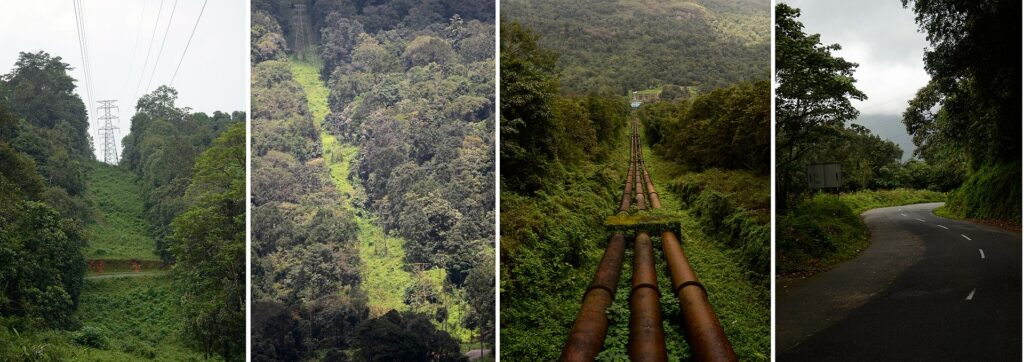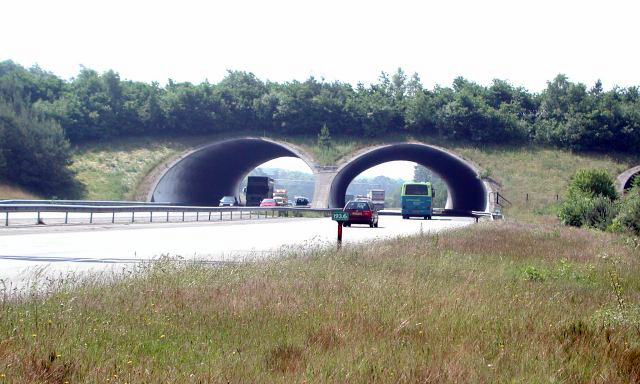Piercing through precious wildlife habitats, linear infrastructure like roads, railway lines, electricity transmission lines, canals and pipelines are altering habitat structure. They even threaten the survival of many species. India being a developing country, a delicate balance needs to maintained between development and protecting the natural environment. Studies estimate that globally more than 3,00,000 km of new railway tracks and 25 million km of roads will be built by 2050 (1). In India, about 50,000 km of road projects have been identified. These are to be completed in the next 5-6 years, with about 20,000 km passing through forests (4). Species like elephants, tigers and leopards are killed along roads and railway lines. Roads have a plethora of other indirect ecological consequences. Moreover, roadkill is one of the biggest threat to wildlife conservation.

The ‘critically endangered’ Great Indian Bustard (GIB) is facing extinction due to collision with electric power lines over its grassland habitat. Surveys conducted in the Thar area for by the Wildlife Institute of India, found 289 carcasses of 30 species including that of the GIB (2). Furthermore, powerlines are catalyzing the destruction of grasslands, through the spread of invasive species. With an annual growth rate of 5% (1), power transmission line network is expanding at an unprecedented rate.
With the linear infrastructure expansion mitigation measures is crucial maintaining habitat connectivity. This t will ensure gene flow; reduce wildlife mortality and human- wildlife conflict.
Structural Mitigation

Structural solutions like overpasses, underpasses and flyovers (the entire road/ railway line is elevated on pillars to allow safe passage of animals) can be constructed along the roads and/or railway lines (3). This has prevented scores of roadkill around the world.
The Famous NH44 Wildlife Underpass – A Hope for Roadkill
One of the most successful wildlife mitigation structures constructed in India is that on the NH-44 section that passes through the Pench Tiger Reserve. The stretch of underpass is 750km- the longest wildlife mitigation structure in India (6). The work on this section by NHAI began in 2010, but it was only after opposition by animal activists and legal intervention, did in 2015, the mitigation structure construction began. (6). A study by the Wildlife Institute of India (4) found 18 different wild species using the underpass(5). This includes 11 tigers. Even reptiles like monitor lizards were observed using these underpasses (5). Camera Traps along with continuous monitoring was done along various Minor Bridges and Animal Underpasses. (4).
Other examples include- upgrading NH-72 passing through Rajaji National Park with flyover for vehicles (3). The underpasses here are used by elephants, leopards etc. Also, fences are being constructed to channel wildlife towards the underpasses (3). Along the NH- 37 passing along the boundary of Kaziranga National Park, four major wildlife corridors are constructed, which are regularly used by wildlife, especially elephants (3). Also, along NH- 54E passing through Lumding Reserve Forest, Assam, flyover underpasses, minor underpasses and culverts for reptiles and other wildlife has been constructed (3). 1.5 m high opaque fencing has also been constructed to reduce light and sound pollution (3).
An example of structural mitigation measure for railway lines is the Chittagong- Cox’s bazaar railway in Bangladesh (3). Along three different PAs, overpasses along with fences have been constructed for safe crossing of wild animals (3).
Other Examples of Structural Mitigation
In case of electric power lines passing through wildlife habitat, the structural solution is making them underground. Avoiding construction of power lines in crucial wildlife habitat will be the best solution, however, retrofitting of existing overhead power lines with bird diverters depending upon the voltage (2), will help in reducing bird mortality.
Other structural measures like natural canopy connectivity and crossing nets for arboreal species and culverts for small animal species like reptiles, small mammals etc. ensures habitat connectivity for all taxa.
Non Structural Mitigation
Non- Structural mitigation measures are early warning systems that help in determining the presence of any species along roads, railways etc. (1). Animal detection system using lidar, radar or microwaves can be used to alert trains in the vicinity to avoid collision (1). Also, the animal can be alerted of an incoming train by using flash systems depending upon the target species (1).
A company in Bhutan developed a passive sensor that detects animal movement and triggers sound and light system to deter elephants (3). Seismic sensors are developed along the railway tracks of Rajaji National Park to detect elephants and alert train drivers (3). In the Lumding Reserve Forest of Assam, warning signs and speed bumps in critical movement areas of elephants have been established. (3) Along with construction of underpasses; their maintenance is equally important. Some of the ways include- By levelling/merging them the surroundings, plantation of shrubs/grasses and daily patrolling by forest guards, close approach to the main highway for common people by plantation of thorny bushes (eg. Zizyphus), weekly cleaning of the underpasses etc. (5).
Also, signboards indicating the presence of wild animals need to be erected for people to know about the presence of wild species so that they can act accordingly. A maximum of 2-3 colors (preferably only green and black), with silhouettes of representative animals and minimal text can be used on these boards to increase its visibility. Reflective material (radium) may be used (3).
Extensive Research required before adding Mitigation Structures
- Sign Surveys (7): To identify specific animal crossing zones; sign surveys include determining animal signs like pellets, scats, pug/ hoof marks or even direct animal sighting (7). This is then mapped using GIS to determine areas frequented by wild animals.
- Identification of hotspots of animal deaths (7): This includes determining the number of roadkill along with evaluation of road visibility and animal detection ability of the driver (7).
- Vehicular speed (7): Determining vehicular speed along with traffic heterogeneity and volume is important for understanding the barrier effect (reduction of animal movements across roads due to traffic, noise, pollution, human activities and physical barriers like fences.) (7)
- Designing of wildlife crossings suitable for the animal species in the landscape (7): Based on roadkill data, GIS based movement model, capture- mark- recapture, genetic sampling, adjacent land- use etc. best locations for wildlife crossing structures is determined (7).
- Camera trapping: One of the most efficient methods for monitoring of wildlife passes and data collection.
Linear infrastructure like canals and pipelines act as source of pollution and favors the spread of invasive species. They also reduce connectivity between populations of wild species. Hence, proper mitigation measures are needed during their establishment.
Biodiversity loss is now globally recognized to be a major threat to the world. With the current rate of linear infrastructure buildup, we need to ensure that this doesn’t gets exacerbated. It is the collaboration wildlife scientists, engineers, architects, politicians and the citizens that we can ensure that mitigation measures are developed and most importantly maintained for all of us- humans and the wild species to survive in the long run.
Written by: Vaishnavi Apte
Help us Help Them!
Help us Help Them! Think Wildlife Foundation is a non profit organization with various conservation initiatives. Our most prominent campaign is our Caring for Pari intiative. Pari is a rehabilitated elephant at the Wildlife SoS Hospital. 25% of the profits from our store are donated to the elephant hospital for Pari. Other than buying our wonderful merchandise, you could donate directly to our Caring For Pari fundraiser.
References
- https://files.worldwildlife.org/wwfcmsprod/files/Publication/file/7v7uq0ikpe_LISA_FinalReport_FINAL.pdf?_ga=2.28509436.178168163.1640763666-1016495876.1636816506
- https://www.conservationindia.org/wp-content/files_mf/Power-line-booklet_1-Nov-18.pdf
- https://files.worldwildlife.org/wwfcmsprod/files/Publication/file/9izehtmuji_2021_12_5_AsETWG_Primer_final_en.pdf?_ga=2.95478492.178168163.1640763666-1016495876.1636816506
- https://wii.gov.in/images/images/documents/publications/rr_2020_monitoring_animals_nh44_ptr.pdf
- https://www.newindianexpress.com/nation/2020/sep/15/conservation-vs-development–wildlife-underpasson-nh-44-looks-promising-report-2196961.html
- https://indiainfrahub.com/2020/main-featured/why-this-elevated-stretch-on-national-highway-44-is-a-hit-with-animals-in-pench-tiger-reserve/
- https://www.researchgate.net/profile/Akanksha-Saxena-2/publication/293813360_Proposed_Mitigation_Measures_for_Maintaining_Habitat_Contiguity_and_Reducing_Wild_Animal_Mortality_on_NH_6_7_in_the_Central_Indian_Landscape/links/56bb7b9e08ae2481ab6ac24d/Proposed-Mitigation-Measures-for-Maintaining-Habitat-Contiguity-and-Reducing-Wild-Animal-Mortality-on-NH-6-7-in-the-Central-Indian-Landscape.pdf
